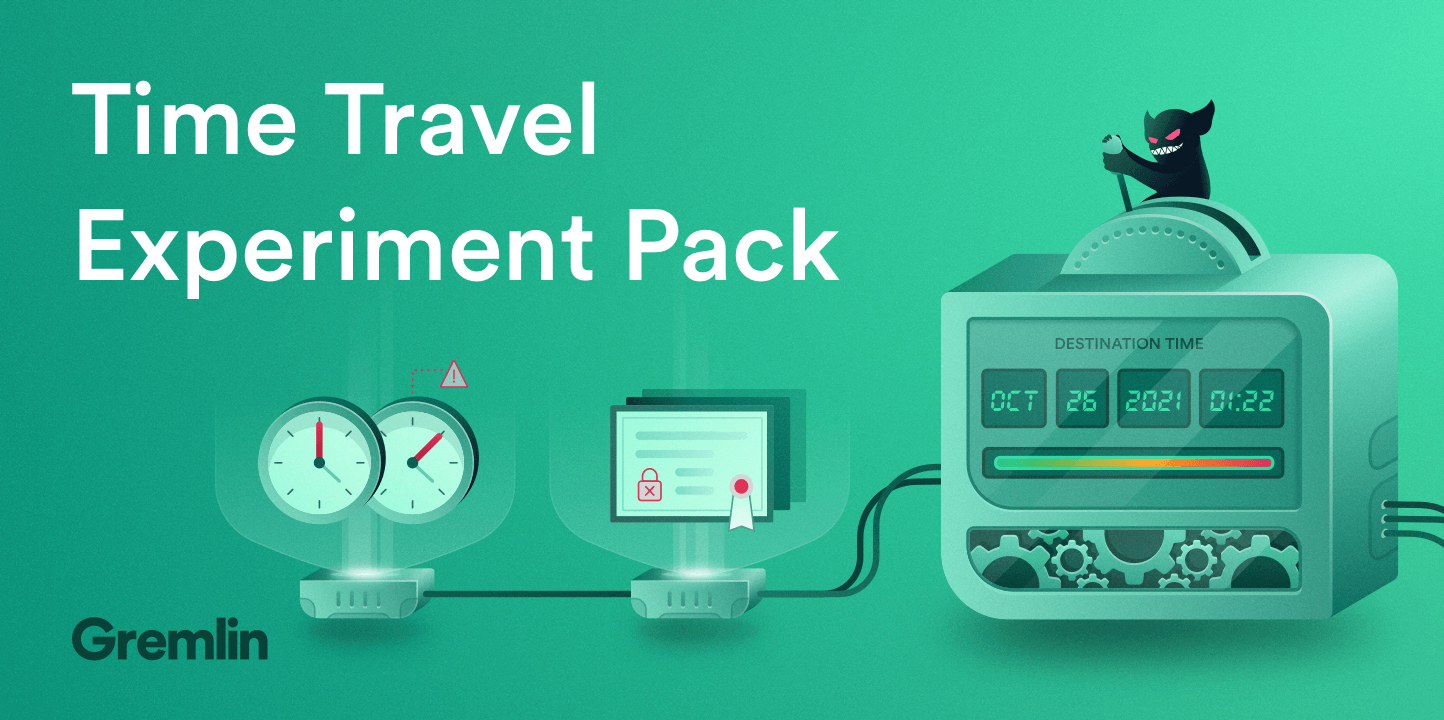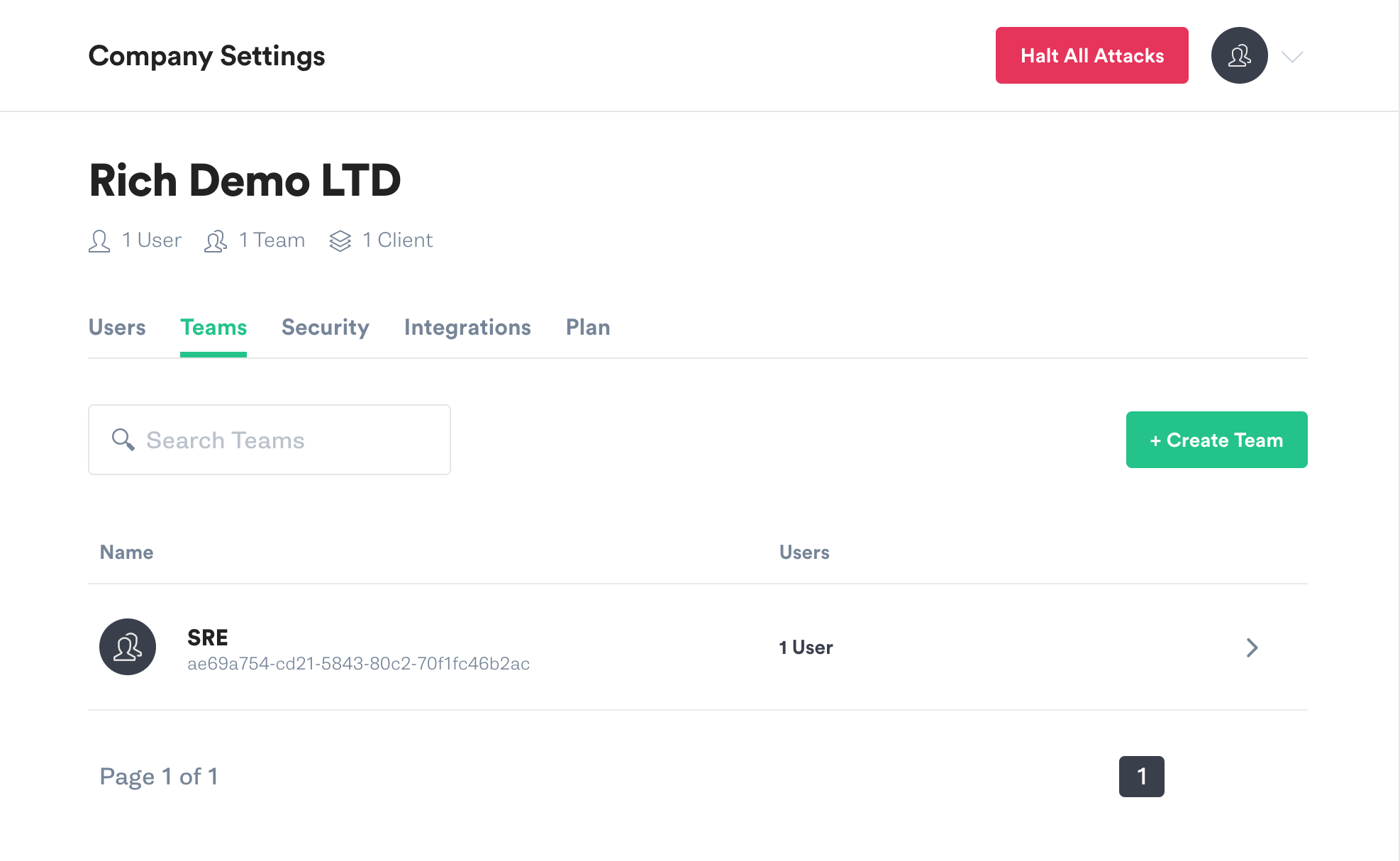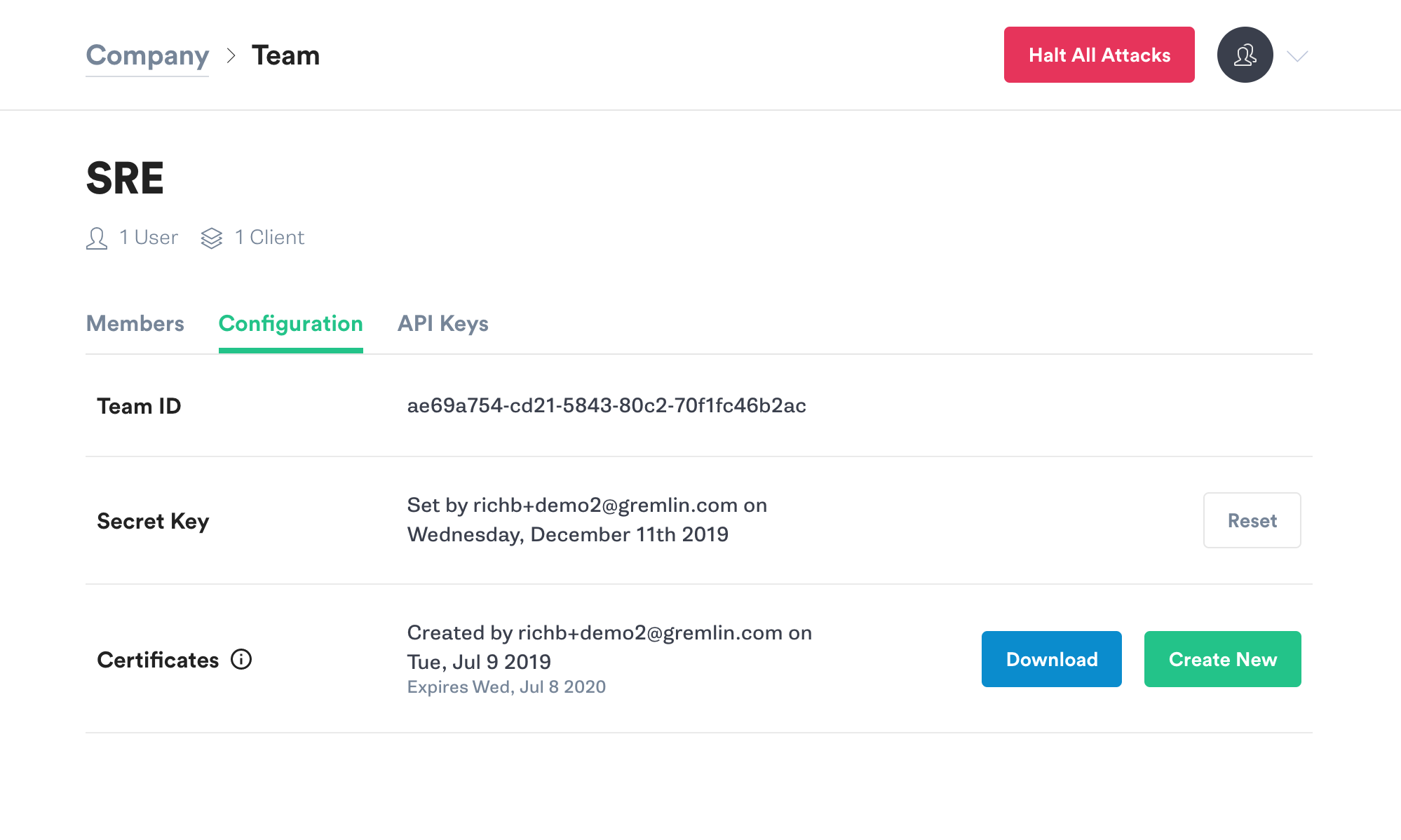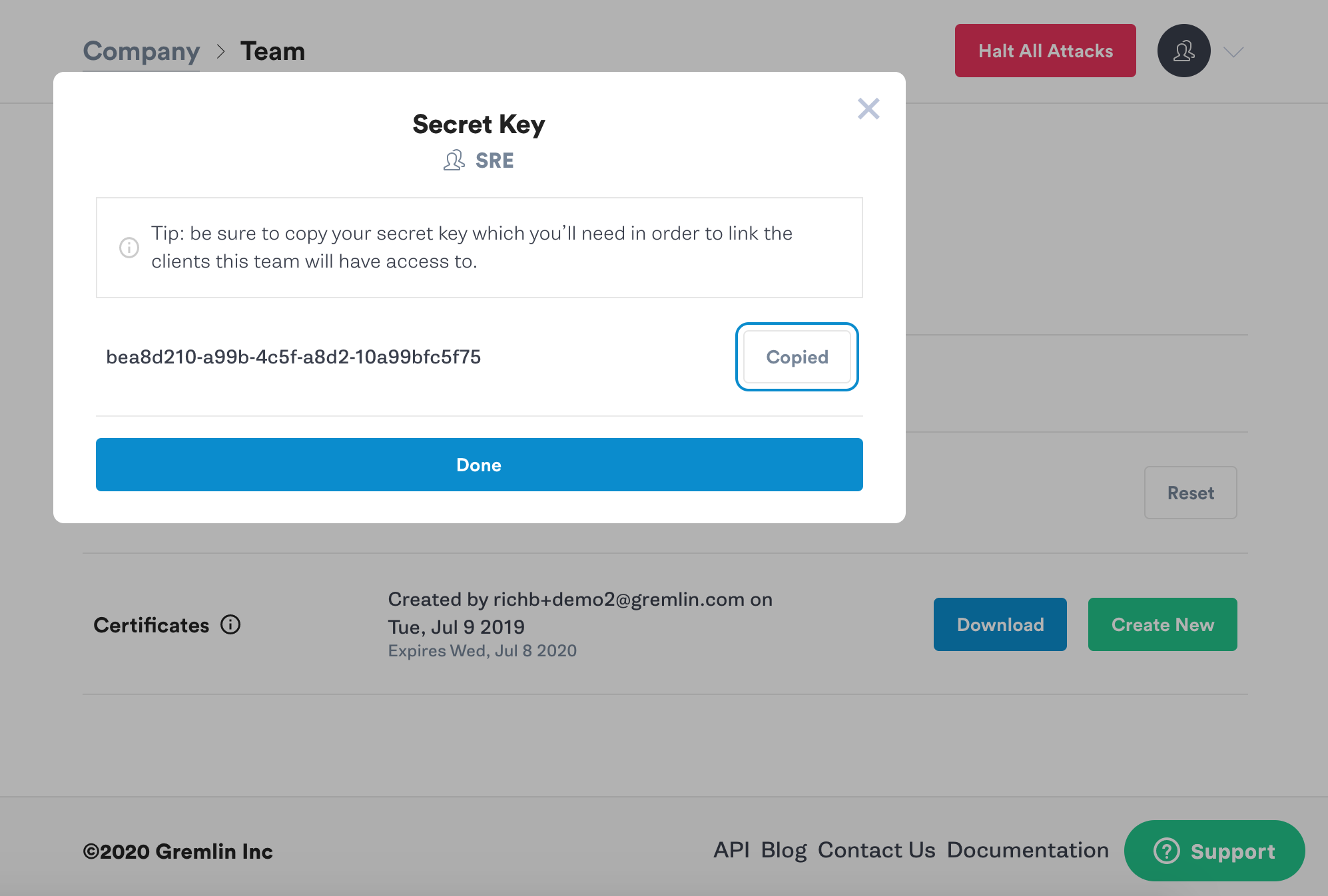
Time Travel Experiment Pack

Description
This Gremlin Time Travel Experiment Pack shares how you can utilize the Gremlin Time Travel attack to change the clock time of cloud infrastructure instances. This attack is cloud-agnostic and will work across AWS, GCP, Azure, DigitalOcean, Linode and more. There are many reasons to regularly use the Time Travel attack. One important reason is to ensure your systems can effectively handle certificate expiration.
What’s Included
- Ability to time travel cloud infrastructure hosts on AWS, Azure, GCP & more
- Ability to time travel with Gremlin installed directly on the instance
What we’ll break
With Gremlin, you have the ability to time travel any instance wherever it may reside.
This pack includes 3 x 5-minute experiments:
- Experiment 1: Time Travel a cloud infrastructure instance using Gremlin
- Experiment 2: Time Travel a cloud infrastructure instance using Gremlin in a Docker container
- Experiment 3: Time Travel a Kubernetes node using Gremlin
What you’ll need
- A Gremlin account (sign up here)
- Your Gremlin daemon credentials
- Cloud Infrastructure hosts (e.g. an AWS EC2 instance)
- Cloud Infrastructure containers (e.g. A DigitalOcean Docker Droplet)
- A kubernetes cluster (e.g. Azure AKS)
Get ready to unleash chaos, get your credentials!
After you have created your Gremlin account (sign up here) you will need to get your Gremlin Daemon credentials. Time Travel requires a full account, contact our team to get an upgrade: sales@gremlin.com
Login to the Gremlin App using your Company name and sign-on credentials. These details were emailed to you when you signed up to start using Gremlin.
Experiment 1: Time Travel a cloud infrastructure host using Gremlin
Step 1.0 - Installing the Gremlin Daemon and CLI
First, ssh into your server and add the Gremlin Debian repository:
1echo "deb https://deb.gremlin.com/ release non-free" | sudo tee /etc/apt/sources.list.d/gremlin.list
Import the repo’s GPG key:
1sudo apt-key adv --keyserver keyserver.ubuntu.com --recv-keys C81FC2F43A48B25808F9583BDFF170F324D41134 9CDB294B29A5B1E2E00C24C022E8EF3461A50EF6
Then install the Gremlin daemon and CLI:
1sudo apt-get update && sudo apt-get install -y gremlind gremlin
Step 1.1 - Register your server to the Gremlin control plane
To install the Gremlin agent and Kubernetes client, you will need your Gremlin Team ID and Secret Key. If you don’t know what those are, you can get them from the Gremlin web app.
Visit the Teams page in Gremlin, and then click on your team’s name in the list.

On the Teams screen click on Configuration.

Make a note of your Team ID.
If you don’t know your Secret Key, you will need to reset it. Click the Reset button. You’ll get a popup reminding you that any running clients using the current Secret Key will need to be configured with the new key. Hit Continue.
Next you’ll see a popup screen that will show you the new Secret Key. Make a note of it.

Initialize Gremlin by running the following command and follow the prompts to enter your Team ID and Secret Key.
1gremlin init
Now you’re ready to run attacks using Gremlin.
Step 1.2 - View the current clock time and disable NTP
Using the built in Linux date tool check the current system time:
1date
You will see a result similar to below:
1Sat Mar 2 00:44:08 UTC 2019
Disable NTP on the instance:
1sudo timedatectl set-ntp false
Step 1.3 - Run a Time Travel Attack Using Gremlin
First click Create Attack.
First choose your target by selecting the host you registered with Gremlin.

Next we will use the Gremlin App to create a Time Travel Attack. Choose the State Category and Select the Time Travel Attack.

Click Unleash Gremlin and the Gremlin Time Travel Attack will time travel your host.
Step 1.4 - Check the new adjusted clock time
Using the built in Linux date tool check the adjusted system time:
1date
Experiment 2 - Time Travel a cloud infrastructure instance using Gremlin in a Docker container
Step 2.0 - Install Docker
In this step, you’ll install Docker.
Add Docker’s official GPG key:
1curl -fsSL https://download.docker.com/linux/ubuntu/gpg | sudo apt-key add -
Use the following command to set up the stable repository.
1sudo add-apt-repository "deb [arch=amd64] https://download.docker.com/linux/ubuntu $(lsb_release -cs) stable"
Update the apt package index:
1sudo apt-get update
Make sure you are about to install from the Docker repo instead of the default Ubuntu 16.04 repo:
1apt-cache policy docker-ce
Install the latest version of Docker CE:
1sudo apt-get install docker-ce
Docker should now be installed, the daemon started, and the process enabled to start on boot. Check that it’s running:
1sudo systemctl status docker
Make sure you are in the Docker usergroup, replace $USER with your username:
1sudo usermod -aG docker $USER
Log out and back in for your permissions to take effect, or type the following:
1su - ${USER}
Step 2.1 View the current clock time
Use the built in Linux date tool check the current system time
1date
You will see a result similar to the following:
1Sat Mar 2 00:44:08 UTC 2019
Disable NTP on the instance:
1sudo timedatectl set-ntp false
Step 2.2 - Set up your Gremlin client credentials
Using your Gremlin login credentials (which were emailed to you when you created your account), log in to the Gremlin App. Open Settings and copy your Team ID and Secret.
Set the following export variables:
1export GREMLIN_TEAM_ID=your_team_id
1export GREMLIN_TEAM_SECRET=your_team_secret
Step 2.3 - Run the Gremlin Daemon in a Container
Use docker run to pull the official Gremlin Docker image and run the Gremlin daemon:
1sudo docker run -d \ --net=host \ --pid=host \ --cap-add=NET_ADMIN \ --cap-add=SYS_BOOT \ --cap-add=SYS_TIME \ --cap-add=KILL \ -e GREMLIN_TEAM_ID="${GREMLIN_TEAM_ID}" \ -e GREMLIN_TEAM_SECRET="${GREMLIN_TEAM_SECRET}" \ -v /var/run/docker.sock:/var/run/docker.sock \ -v /var/log/gremlin:/var/log/gremlin \ -v /var/lib/gremlin:/var/lib/gremlin \ gremlin/gremlin attack time_travel
Make sure to pass in the three environment variables you set in Step 4. If you don’t, the Gremlin daemon cannot connect to the Gremlin backend.
Use docker ps to see all running Docker containers:
1sudo docker ps
You will see a result similar to the following:
1CONTAINER ID IMAGE COMMAND CREATED STATUS PORTS NAMES
17167cacb2536 gremlin/gremlin "/entrypoint.sh daem…" 40 seconds ago Up 39 seconds practical_benz
Step 2.4 - Check the new adjusted clock time
Using the built in Linux date tool check the adjusted system time:
1date
Experiment 3 - Time Travel a Kubernetes node using Gremlin
Kubernetes is a container management system which is built with reliability in mind. Architecture is commonly 1 primary and 2 or more nodes which are replicated from the master. When the primary dies the nodes are ready to replace it. When one node dies another will be ready to replace it.
To create a Kubernetes cluster follow our guide on "How to Use and Install Kubernetes with Weave Net". Alternatively you can use a managed Kubernetes service such as GKE, EKS and AKS.
Step 3.0 - Install the Gremlin Agent
The simplest way to install the Gremlin agent on your Kubernetes cluster is to use Helm. If you do not already have Helm installed, go here to get started. Once Helm is installed and configured, the next steps are to add the Gremlin repo and install the client.
Add the Gremlin Helm chart:
1helm repo add gremlin https://helm.gremlin.com
Create a namespace for the Gremlin Kubernetes client:
1kubectl create namespace gremlin
Next you will run the helm command to install the Gremlin client. In this command there are three placeholder variables that you will need to replace with real data. Replace $GREMLIN_TEAM_ID with your Team ID from Step 1.1, and replace $GREMLIN_TEAM_SECRET with your Secret Key from Step 1.1. Replace $GREMLIN_CLUSTER_ID with a name for the cluster.
If you are using Helm v3, run this command:
1helm install gremlin gremlin/gremlin \2 --namespace gremlin \3 --set gremlin.secret.managed=true \4 --set gremlin.secret.type=secret \5 --set gremlin.secret.teamID=$GREMLIN_TEAM_ID \6 --set gremlin.secret.clusterID=$GREMLIN_CLUSTER_ID \7 --set gremlin.secret.teamSecret=$GREMLIN_TEAM_SECRET
For older versions of Helm, use the --name option:
1helm install gremlin/gremlin \2 --name gremlin \3 --namespace gremlin \4 --set gremlin.secret.managed=true \5 --set gremlin.secret.type=secret \6 --set gremlin.secret.teamID=$GREMLIN_TEAM_ID \7 --set gremlin.secret.clusterID=$GREMLIN_CLUSTER_ID \8 --set gremlin.secret.teamSecret=$GREMLIN_TEAM_SECRET
If you’re not sure which version of Helm you’re using, run this command:
1helm version
For more information on the Gremlin Helm chart, including more configuration options, check out the chart on Github.
Step 3.1 - View the current clock time and disable NTP
Use the built in Linux date tool check the current system time
1date
You will see a result similar to the following:
1Sat Mar 2 00:44:08 UTC 2019
Disable NTP on the instance:
1sudo timedatectl set-ntp false
Step 3.2 - Creating attacks using the Gremlin App
Example: Creating a Time Travel Attack against a Kubernetes node using the Gremlin App
You can use the Gremlin App or the Gremlin API to trigger Gremlin attacks. You can view the available range of Gremlin Attacks in Gremlin Help.
To create a Time Travel Attack, click Attacks in the left Navigation bar and New Attack.
Host targeting should be selected by default. Click on the Exact button to expand the list of available hosts, and select one of them. You’ll see the Blast Radius for the attack is limited to 1 host.
Click “Choose a Gremlin,” and then select State and Time Travel.
Leave the Length set to 60 seconds. Leave the radio button for NTP set to “No,” as we’ve already disabled NTP on the host. Leave the offset set to 86400 second. That’s the amount of clock drift that will be introduced. Then hit the green Unleash Gremlin button.
When your attack is finished it will move to Completed Attacks in the Gremlin App. To view the logs of the Attack, click on the Attack in Completed Attacks then click to the arrow to view the logs.
Step 3.3 - Check the new adjusted clock time
Using the built in Linux date tool check the adjusted system time:
1date
Further Attacks
Gremlin free unlocks the ability to perform Shutdown and CPU attacks. To unlock Time Travel upgrade your Gremlin account by contacting our team sales@gremlin.com.
Related



Avoid downtime. Use Gremlin to turn failure into resilience.
Gremlin empowers you to proactively root out failure before it causes downtime. See how you can harness chaos to build resilient systems by requesting a demo of Gremlin.
Get started